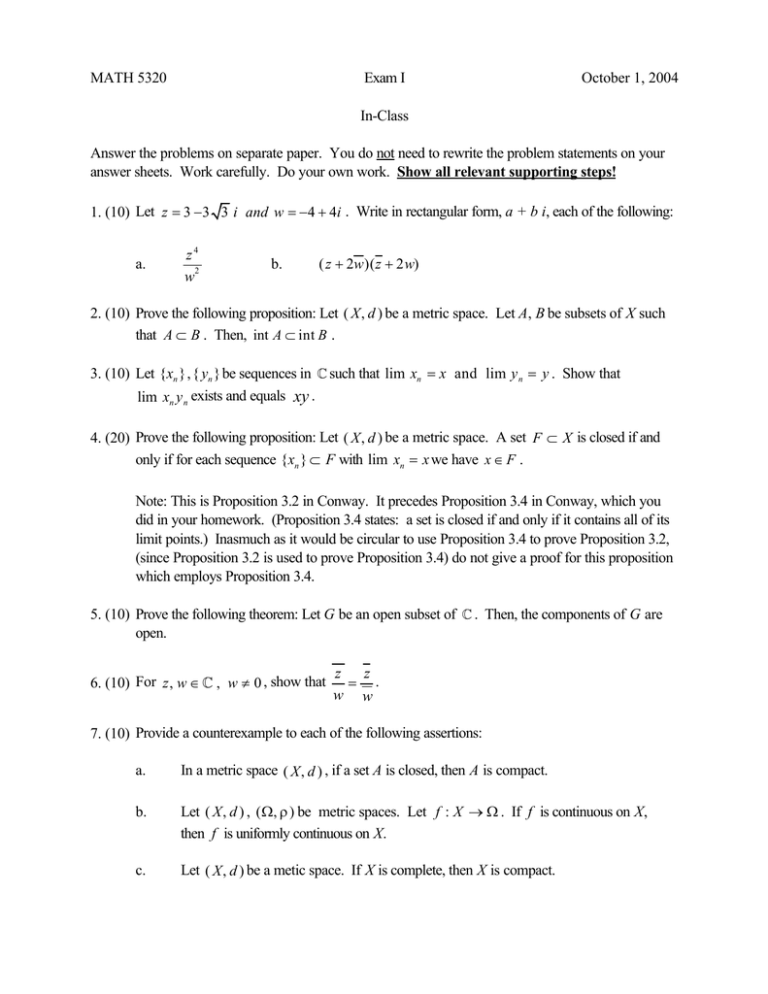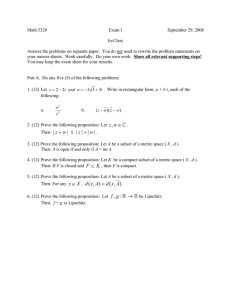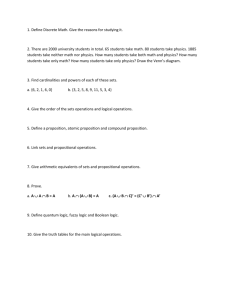MATH 5320 Exam I October 1, 2004 In-Class
advertisement

MATH 5320
Exam I
October 1, 2004
In-Class
Answer the problems on separate paper. You do not need to rewrite the problem statements on your
answer sheets. Work carefully. Do your own work. Show all relevant supporting steps!
1. (10) Let z = 3 −3 3 i and w = −4 + 4i . Write in rectangular form, a + b i, each of the following:
a.
z4
w2
b.
( z + 2w)( z + 2 w)
2. (10) Prove the following proposition: Let ( X , d ) be a metric space. Let A, B be subsets of X such
that A ⊂ B . Then, int A ⊂ int B .
3. (10) Let {xn },{ yn } be sequences in £ such that lim xn = x and lim y n = y . Show that
lim xn y n exists and equals xy .
4. (20) Prove the following proposition: Let ( X , d ) be a metric space. A set F ⊂ X is closed if and
only if for each sequence {xn } ⊂ F with lim xn = x we have x ∈ F .
Note: This is Proposition 3.2 in Conway. It precedes Proposition 3.4 in Conway, which you
did in your homework. (Proposition 3.4 states: a set is closed if and only if it contains all of its
limit points.) Inasmuch as it would be circular to use Proposition 3.4 to prove Proposition 3.2,
(since Proposition 3.2 is used to prove Proposition 3.4) do not give a proof for this proposition
which employs Proposition 3.4.
5. (10) Prove the following theorem: Let G be an open subset of £ . Then, the components of G are
open.
6. (10) For z , w ∈ £ , w ≠ 0 , show that
z
z
= .
w w
7. (10) Provide a counterexample to each of the following assertions:
a.
In a metric space ( X , d ) , if a set A is closed, then A is compact.
b.
Let ( X , d ) , ( Ω, ρ ) be metric spaces. Let f : X → Ω . If f is continuous on X,
then f is uniformly continuous on X.
c.
Let ( X , d ) be a metic space. If X is complete, then X is compact.
d.
Let ( X , d ) , (Ω , ρ ) be metric spaces. Let f n : X → Ω , f : X → Ω . If
f n → f on X, then f n
e.
uuur f
uniformly
on X.
Let ( X , d ) , ( Ω, ρ ) be metric spaces. Let f : X → Ω . If f is continuous on X
and if G is an open subset of X, then f (G) is an open subset of Ω .
8. (20) Classification Problem. Correctly identify whether the following subsets of £ are: (a) open; (b)
closed; (c) connected; (d) polygonally path connected; (e) compact; (f) complete; (g) bounded;
(h) region. You do not need to provide a rationale for your classification. Fill out the
classification information on the attach table.
A.
{z = x + iy : xy < 2, xy > 0} ∩ B (0,4)
B.
{z = x + iy : 0 < y < e x , −∞ < x < ∞ } ∩ {z : | I m z |< 2}
C.
{z = x + iy :
x2 y2
+
≤ 1} \ B(0,3)
25 4
D.
{B (0,1)\ B(
1
∞
E.
Ul
n =1
n
2
}
, 1 2 ) ∩ { z : R e z > 0}
, where each l n = [0, cis ( π )]
2n
Classification Table for Problem 8
open
A
B
C
D
E
closed
connected
polygonally
path
connected
compact
complete
bounded
region








